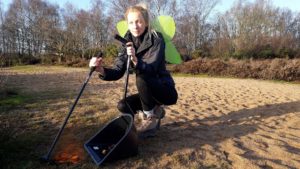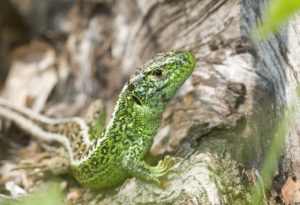“Poo fairy” urges dog walkers to “bag it and bin it” to help our wildlife
January 31, 2020
Dog poos don’t just disappear by magic – and can cause long-term harm to fragile wildlife havens.
That’s the message from Katy Sherman, Engagement Officer for the lottery-funded Heathlands Reunited project, which is working to protect and enhance the 41 nationally-important heaths in the region.
 Katy and other partners in the project are urging dog walkers to “bag it and bin it” after 123 dog poos were counted along the main pathway at Broxhead Common. The Hampshire nature reserve is home to several rare and specialised heathland species, including the sand lizard, Dartford Warbler, woodlark and the silver-studded blue and grayling butterflies.
Katy and other partners in the project are urging dog walkers to “bag it and bin it” after 123 dog poos were counted along the main pathway at Broxhead Common. The Hampshire nature reserve is home to several rare and specialised heathland species, including the sand lizard, Dartford Warbler, woodlark and the silver-studded blue and grayling butterflies.
Katy explained that dog poos can cause long-term damage to the heathland habitat.
“Whatever some people may believe, there’s no such thing as the dog poo fairy”, said Katy, who donned “poo fairy” wings during the clean-up of the dog fouling to help raise awareness of the problem. The poos had also previously been sprinkled with eco-friendly paint powder to highlight the issue for dog walkers on the site.
“It’s also a myth that it is fine for the environment to leave dog poo on the ground to ‘decompose’. Heathlands in particular are very vulnerable. These heaths have nutrient-poor soils and it’s this lack of nutrients that allows the heathers to thrive and therefore supports all these rare animals.
“Dog poo contains nitrates which leach into the soil and, over time, change the soil’s profile. It means that invasive species such as bracken can grow, outcompete the heather and undo all the conservation work. Without management, it could mean we lose these heathlands, a habitat rarer than the rainforest.
“Dog poo also contains bacteria that can get into the water table and be passed on to humans and livestock, causing serious illness potentially.”
Katy cited the National Park’s Take The Lead the campaign, which encourages dog walkers to enjoy the countryside responsibly by sticking to the paths on sites with ground nesting birds from March to September, bagging and binning dog poo and keeping dogs on leads near livestock.

Katy added: “We’re urging people to keep their dogs in sight and to always bag and bin their dog poo, wherever and whenever they choose to go. You could even make it a resolution for 2020 and, in doing so, help our wildlife thrive.”
At Broxhead Common, there is a dog poo bin at the layby near the entrance.
Katy added: “On many special protection areas like this, there aren’t any dog poo bins but it’s still the owner’s responsibility to pick that poo and take it home or put in a general waste bin.
“We also promote dicky bags which are a leak-proof bag with air freshener in it. You can pop your dog poo into that, zip it up and not even know you’ve got it. Then you can safely dispose of the bag in your bin at home or any public bin.”
Katy works with a team of dog ambassadors who are members of the local dog walking community and help to spread the message about responsible dog walking. Anyone interested in becoming an ambassador can email heathlands@southdowns.gov.uk
Broxhead Common, just outside Bordon, is 42 hectares of dry heathland, as well as birch and oak woodland. Its wildlife is so rare that it has Special Protection Area status and is also a Site of Special Scientific Interest (SSSI).
Heathlands Reunited is a National Lottery Heritage funded partnership project and is working to save our heaths, which provide a habitat to all 12 of the UK’s native reptiles. Eleven organisations have joined forces to expand the existing heathland left in the National Park. The Heathlands Reunited partnership aim to create an area of heathland greater than 1,200 football pitches over a five-year project.
